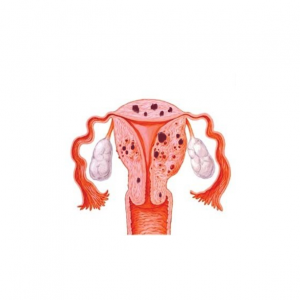Adenomyosis
Adenomyosis
What is adenomyosis?
Adenomyosis is a condition where cells from the lining of the uterus (the endometrium) are found within the muscle layer of the uterus (the myometrium). It is found in approximately 1 in 10 women of reproductive age and is most common in women aged 40- 55 who have had children.


What causes adenomyosis?
The pathogenesis of adenomyosis is not well understood but it is possible that weakened bonds between the myometrial muscle cells allow the migration and implantation of endometrial cells within the muscle layer. This process may result from a cycle of repeated injury and attempted healing at the endometrial/myometrial interface. Female sex hormones then result in the maintenance and progression of the condition.
It is likely that there are also genetic and immunological factors involved in the development of the condition. There is no known way to prevent the condition.
What are the signs & symptoms of adenomyosis?
In the early phase of adenomyosis development, most women with the condition may have no symptoms at all. The only indication of the possible presence of adenomyosis often comes from incidental ultrasound findings. 80% of women with adenomyosis will also have uterine fibroids which can contribute to the symptoms experienced.
As the disease progresses, the most common symptoms of adenomyosis are heavy menstrual bleeding and period pain.
Other symptoms include:
- pain during intercourse
- generalised pelvic pain
- pressure symptoms on the bowel & bladder when the adenomyosis causes gross uterine enlargement
- subfertility
On examination the uterus may be enlarged and/or tender.
What investigations can be performed to diagnose the condition?
- Ultrasound is the first line imaging test which can suspect the presence of adenomyosis based on findings such as a mottled appearing myometrium, small cystic spaces within the myometrium and an enlarged, globular appearing uterus.
- MRI is often the second line investigation where a thickening of the zone between the endometrium & myometrium is the most characteristic sign of adenomyosis
Ultimately the diagnosis of adenomyosis can only be made by a pathologist after a hysterectomy or uterine specimen is analysed.
What treatment options are available?
As adenomyosis resides within the muscle wall of the uterus it can be a difficult condition to manage in women who have major symptoms but have not started or completed childbearing.
For women wishing to retain their uterus, medical management options include Mirena or GnRH analogues.
- Mirena intrauterine device works by causing a thinning of the endometrium and hence it may help to reduce heavy bleeding and menstrual pain associated with adenomyosis. However as Mirena does not suppress ovarian hormone production, women may continue to experience pain as the adenomyosis continues to develop and result in an increase in uterine size.
- GnRH analogues such as Zoladex are designed to suppress normal ovarian hormonal production and hence result in a temporary chemical menopause. In such a state most women will not experience periods and the uterine size & pelvic pain may reduce. Unfortunately some women may not be able to tolerate the menopausal side-effects or symptoms may recur following cessation of the treatment.
Uterine artery embolisation (where a catheter is inserted into the blood vessels in the groin and feed up to the uterine artery followed by injection of small particles to occlude the vessels) can be used to reduce the blood supply to the adenomyosis and for some women may improve their symptoms. Pregnancy following this procedure may however have additional complications hence for women desiring future fertility this modality is generally not recommended.
In cases of localised adenomyosis (termed an adenomyoma) it may be possible to excise the abnormal tissue laparoscopically which may be appropriate particularly in women with subfertility.
In women who have completed or do not desire childbearing, definitive treatment for adenomyosis involves a hysterectomy, resulting in complete removal of the affected uterine tissue.
In women approaching menopausal age, symptoms related to adenomyosis often resolve spontaneously with the loss of ovarian hormones. Hence, generally women with adenomyosis do not require treatment after menopause.
